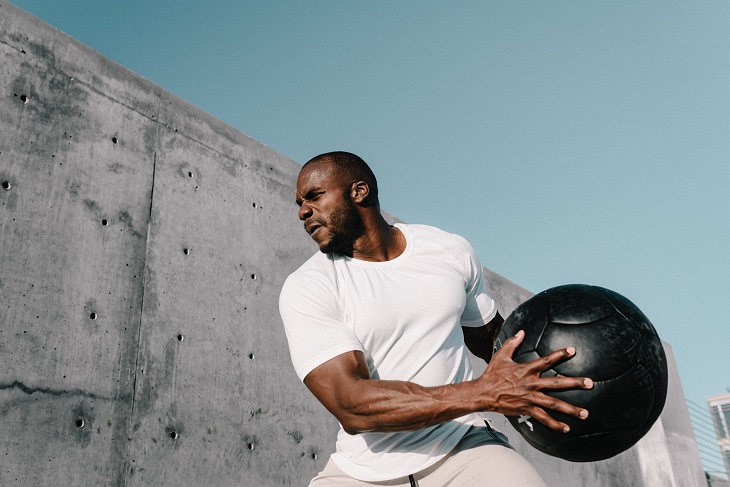It’s no secret that working out is good for the body. Exercise has many health benefits, including improving heart health, lowering the risk of developing diseases, and reducing the symptoms of mood disorders such as anxiety and depression. Following a workout, many people feel energized and invigorated. There are times, however, when working out can lead to soreness and stiffness in the muscles.
Those who have started a new workout routine or those who continue to build on their routine to challenge themselves will likely experience some muscle soreness the day after a workout. But is muscle soreness normal? And why does it happen at all?
Here’s why your muscles get sore after a workout – and what you can do about it.
Why are my muscles sore after working out?
Muscle soreness after a workout is referred to as delayed onset muscle soreness, or DOMS for short. The reason muscles begin to feel sore after a change in movement, routine, or intensity of your workout comes down to simple muscle damage. While you put stress on your muscles in a workout, muscle fibers begin to experience microscopic damage and break down. This is what causes pain.
The good news is that because of this, the muscle fibers then have to repair themselves – making them stronger and larger after recovery than they were before. This process is what leads to the workout gains most people are aiming for.

Is it normal to be sore after a workout?
Depending on the type of pain, muscle soreness is usually a normal part of pushing yourself in your workouts. As mentioned above, it’s also a good sign that the work you’re putting into your body is leading to the desired results. However, there are some differences in the pain that can indicate when you may be experiencing something other than the normal soreness associated with an effective workout.
If you are pushing your body too far during your workouts, the severity of the soreness may be so great that walking up stairs or lifting your arms above your head become difficult tasks. This can indicate that you are attempting to go further than your body can handle too rapidly. Giving your muscles the chance to get used to workouts slowly over time will still result in some soreness, but it significantly decreases your risk of injury.
Is it muscle soreness or an injury?
There are a few stark differences between normal muscle soreness following a workout and actual injury. These should be paid attention to, because if an injury isn’t addressed, it can lead to further complications and eventually make it hard to work out altogether. In typical muscle soreness, the body is likely to feel achy, stiff, or tight, with the soreness affecting an entire muscle group. It should also dissipate in the days following your workout routine, and/or when those muscles are worked out again.
When there is an injury to blame for your muscle soreness, that pain will likely be different. It will feel sharp, stabbing, or deep, and will often be localized to one spot. If there is any swelling in the area, that is also a sign that it isn’t typical muscle soreness and that an injury may have occurred. If you go back to work out the same muscle again and the pain becomes more severe, that’s a good indicator of an injury as well.
How to avoid sore muscles after workouts
Although it’s not possible to completely avoid muscle soreness when starting up a new workout routine or changing around the types of exercises you do, there are ways you can help to lessen the soreness. Research has shown that warming up before exercising can greatly decrease DOMS following a workout. Warming up increases blood flow to the area and gets muscles ready for the movements you’re about to perform. Cooling down and stretching following a workout is also vital because it circulates all the blood away from the area to help with recovery.
Staying hydrated is also an important part of avoiding overly sore muscles after a workout. If you are dehydrated, you may experience worsened muscle soreness and fatigue. You will also want to keep up with your workouts. It might seem counterintuitive, but immobilizing a muscle group after working it out can actually prolong or increase muscle soreness. Finally, you’ll want to ensure that you have the proper form when doing your exercises. The wrong form can lead to injury.

How to relieve sore muscles after workouts
There are some good ways to help to relieve muscle soreness after working out that can help drive your progress and keep you in a good routine. Eating foods or taking supplements with amino acids can help to aid in recovery by decreasing muscle damage. Applying heat to the muscles may also help to ease soreness. Research has shown that applying moist heat to the muscles directly after working out helped to reduce the duration and severity of DOMS.
You may also want to invest in a foam roller. Foam rollers are used as a tool in self-massage and can help to relieve muscle soreness while also improving muscle fatigue and overall flexibility.
The final word: muscle soreness after a workout is normal, and often means that what you’re doing is working. But it’s always important to know your body and its limits when exercising. Pushing yourself can help you achieve your health goals, but going too far can hinder your progress.
Featured image by Alonso Reyes on Unsplash